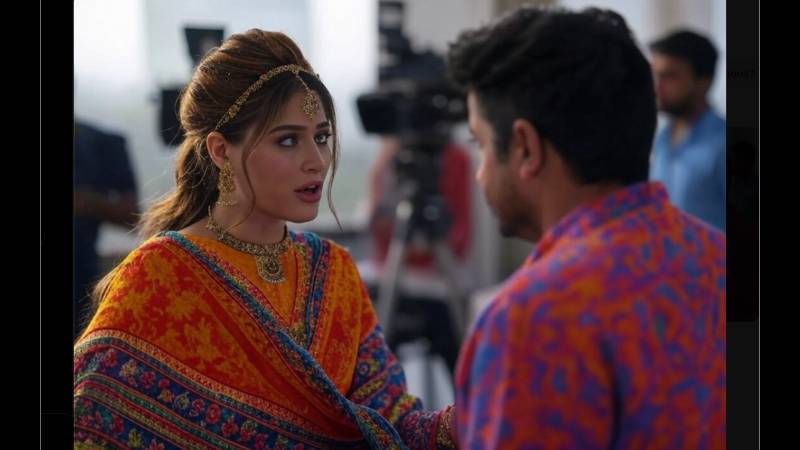
“Kahaani aagy bharhnay lagy to dar lgnay lagta hai k khatm ho jaey gi”
Looking at some pictures from my school days, the voice of a lady echoed in my mind. I couldn’t help but think: where did I hear this sentence so deep and touching? Somewhere down the same day, while I was mindlessly scrolling through my Facebook feed, a video of Bushra Ansari popped up. Here was the moment when I realized that the voice in my head was of Jahan Aara Begum, played by Bushra Ansari in the ever-so-famous drama Aangan Tehrra. This drama was produced in 1984; I watched it on my roommate’s recommendation in 2018. Yet the gap of almost 40 years could not make the eloquence of its dialogues fade away. This is just one out of so many impactful dramas that PTV produced back in the day.
Pakistani dramas have played a pivotal role in shaping the country’s entertainment landscape, evolving from simple, literature-inspired narratives to dynamic, high-budget productions that appeal to a global audience. Since the establishment of the Pakistan Television Corporation (PTV) in 1964, the industry has undergone a remarkable transformation, transitioning from the golden age of PTV to the fast-paced era of private channels and digital platforms. This shift has introduced a wealth of thematic and stylistic diversity, offering a rich tapestry of storytelling that reflects the changing times. A closer examination of this evolution provides a deeper understanding of how narratives in Pakistani television have developed over the decades.
With the expansion of the global audience, advancements in production techniques, and the rise of digital platforms, Pakistani dramas have become more diverse than ever after 2015
In its early years, PTV produced dramas that emphasized literary depth, realistic characters, and strong moral narratives, marking the beginning of an era defined by quality storytelling. Whether it was Khuda Ki Basti (1969), which depicted the harsh realities of poverty following the partition of the subcontinent, Dhoop Kinare (1986), which portrayed a sophisticated and timeless love story, or Waris, which explored the dark side of feudal politics in Punjab and even caused traffic jams during its broadcast times, these dramas were characterized by their literary adaptations, social messages, and minimalist production values. One of the most commendable aspects of these dramas was their moral depth, which often outweighed the allure of commercialized entertainment. These slow-paced yet deeply engaging dramas are not only cultural treasures but have also left an indelible mark on everyday language, imbuing it with a romantic quality that ensures their enduring significance.
As media decentralization took hold in the 2000s, private TV channels such as HUM, Geo, ARY, and others emerged, revolutionizing the drama industry in Pakistan. This groundbreaking shift ushered in a wave of innovative concepts that reshaped storytelling and captivated audiences. The narrative was no longer state-controlled, and the year-long sagas that once dominated the airwaves began to fade, though inclusivity saw a decline. Dramas such as Humsafar (2011), Meri Zaat Zarra-e-Benishan (2009), and Zindagi Gulzar Hai (2012) are emblematic of this era. During this time, female characters grew stronger and often took centre stage as protagonists. The thematic spectrum also expanded significantly, as evidenced by Meri Zaat Zarra-e-Benishan, which delved into a personal journey of spiritual exploration, and Zindagi Gulzar Hai, which showcased Kashaf, a resilient female lead navigating life’s challenges. Another notable change during this period was the introduction of OST (Original Soundtrack) culture, which heightened public engagement. However, I find this trend to be overly dramatized. While the frequency of strong female roles increased, the depth of their portrayal often remained superficial.
With the expansion of the global audience, advancements in production techniques, and the rise of digital platforms, Pakistani dramas have become more diverse than ever after 2015. The industry’s international reach has led to the creation of high-budget, commercialized productions. Dramas such as Udaari (2016), Parizaad (2021), Khaei (2024), and Zard Patto’n Ka Bunn (2024) feature powerful and socially relevant storytelling, addressing issues such as child abuse, caste systems, flawed traditions, and population growth. While these dramas are undeniably captivating, there has been a noticeable shift in narrative focus from language and dialogue to graphics, sound effects, and elaborate sets. It is almost astonishing how technological advancements have overshadowed the linguistic eloquence last seen in dramas like Quddusi Sahab Ki Bewah (2012). However, it is important to acknowledge that the increased demand for content has also led to the repetition of certain themes. Toxic relationships, family politics—particularly among women—and poorly romanticized love stories have become dominant, often at the expense of originality.
In recent years, producers have begun experimenting with new formats. A web series titled Barzakh has emerged and been widely applauded, signalling a fresh direction for the industry. While nostalgia for classic dramas remains strong, it is undeniable that Pakistani dramas have evolved remarkably. However, challenges such as censorship and funding limitations continue to cast uncertainty over the future of the industry. Despite these hurdles, the resilience and creativity of Pakistani storytellers ensure that the legacy of its dramas will endure, adapting to the demands of a rapidly changing world.

